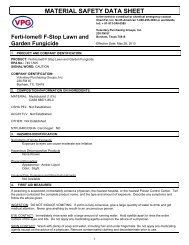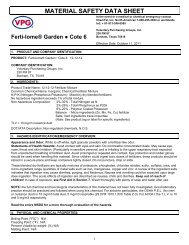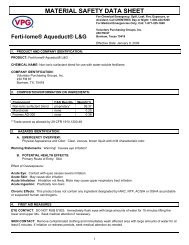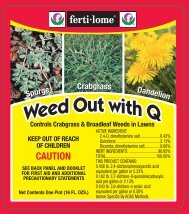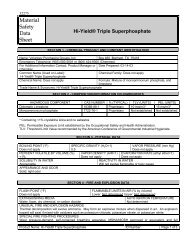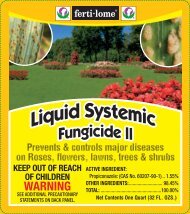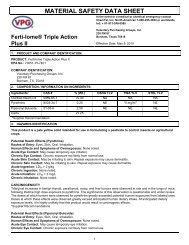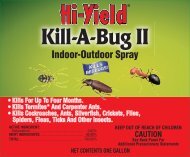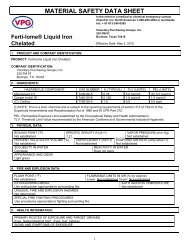Hi-Yield Grass Killer Postemergence Herbicide MSDS - Do My Own ...
Hi-Yield Grass Killer Postemergence Herbicide MSDS - Do My Own ...
Hi-Yield Grass Killer Postemergence Herbicide MSDS - Do My Own ...
Create successful ePaper yourself
Turn your PDF publications into a flip-book with our unique Google optimized e-Paper software.
MATERIAL SAFETY DATA SHEETFor Chemical Emergency, Spill, Leaf, Fire, Exposure, orAccident, Call CHEMTREC Day or Night: 1-800-424-9300For Medical Emergencies Only, Call: 1-877-325-1840<strong>Hi</strong>-<strong>Yield</strong>® <strong>Grass</strong> <strong>Killer</strong>Voluntary Purchasing Groups, Inc.230 FM 87Bonham, Texas 75418Effective Date: December 19, 20081. PRODUCT AND COMPANY IDENTIFICATION:PRODUCT: <strong>Hi</strong>-<strong>Yield</strong>® <strong>Grass</strong> <strong>Killer</strong>EPA No.: 7969-58-7401COMPANY IDENTIFICATION:Voluntary Purchasing Groups, Inc.230 FM 87Bonham, TX. 754182. COMPOSITION / INFORMATION ON INGREDIENTS:CAS NUMBER CONTENT (W) CHEMICAL NAME74051-80-2 18.0% Sethoxydim6742-94-5 65.35% solvent naphtha91-20-3 7.32% naphthalene9.33% Proprietary ingredients3. HAZARD IDENTIFICATION:EMERGENCY OVERVIEWWarning: Causes substantial but temporary eye injuryHARMFUL IF SWALLOWED.KEEP OUT OF REACH OF CHILDREN.KEEP OUT OF REACH OF DOMESTIC ANIMALS.Avoid contact with the skin, eyes and clothing.POTENTIAL HEALTH EFFECTSSee Product Label for additional precautionary statements.Primary routes of exposureRoutes of entry for solids and liquids include eye and skin contact, ingestion and inhalation. Routes of entry for gasesinclude inhalation and eye contact. Skin contact may be a route of entry for liquefied gases.Acute toxicity:Slightly toxic after single ingestion. Relatively nontoxic after short-term inhalation. Slightly toxic after short-term skincontact.Irritation:May cause moderate irritation to the skin. Causes substantial but temporary eye injury.Sensitization:Skin sensitizing effects were not observed in animal studies.Medical conditions aggravated by overexposure:Existing dermatitis may be aggravated by exposure.Potential environmental effectsAquatic toxicity:There is a high probability that the product is not acutely harmful to fish.1
MATERIAL SAFETY DATA SHEETFor Chemical Emergency, Spill, Leaf, Fire, Exposure, orAccident, Call CHEMTREC Day or Night: 1-800-424-9300For Medical Emergencies Only, Call: 1-877-325-1840<strong>Hi</strong>-<strong>Yield</strong>® <strong>Grass</strong> <strong>Killer</strong>Voluntary Purchasing Groups, Inc.230 FM 87Bonham, Texas 75418Effective Date: December 19, 2008Acutely harmful for aquatic invertebrates.Very toxic (acute effect) to aquatic plants.Terrestrial toxicity:With high probability not acutely harmful to terrestrial organisms.Acutely toxic to honeybees.4. FIRST-AID MEASURESGeneral advice:First aid providers should wear personal protective equipment to prevent exposure. Remove contaminated clothing. Moveperson to fresh air. If person is not breathing, call 911 or ambulance, then give artificial respiration, preferable mouth-tomouthif possible. Call a poison control center or physician for treatment advice. Have the product container or label withyou when calling a poison control center or doctor or going for treatment.If inhaled:Remove the affected individual into fresh air and keep the person calm.If on skin:Rinse skin immediately with plenty of water for 15-20 minutes.If in eyes:Hold eyes open and rinse slowly and gently with water for 15 to 20 minutes. Remove contact lenses, if present, after first5 minutes, then continue rinsing.If swallowed:Never induce vomiting or give anything by mouth if the victim is unconscious or having convulsions. <strong>Do</strong> not inducevomiting. Have person sip a glass of water if able to swallow.Note to physician:Hazards: Because of the increased risk of chemical pneumonia or pulmonary edema caused by aspirating of thehydrocarbon solvent, vomiting should be induced only under professional supervision.Antidote: No known specific antidote.Treatment: Treat symptomatically.5. FIRE-TREATING MEASURES:Flash Point: 145°FAuto ignition: 443°CLower explosion limit: 1.3% (V) (70°C)Upper explosion limit: 5.3%(V) (103°C)Suitable extinguishing media:Foam, dry extinguishing media, carbon dioxide, and water sprayHazards during fire fighting:Carbon monoxide, carbon dioxide, Sulphur dioxide, nitrogen oxide, nitrogen dioxide, Hydrocarbons.If product is heated above decomposition temperature, toxic vapors will be released. The substances/groups ofsubstances mentioned can be released if the product is involved in a fire.2
MATERIAL SAFETY DATA SHEETFor Chemical Emergency, Spill, Leaf, Fire, Exposure, orAccident, Call CHEMTREC Day or Night: 1-800-424-9300For Medical Emergencies Only, Call: 1-877-325-1840<strong>Hi</strong>-<strong>Yield</strong>® <strong>Grass</strong> <strong>Killer</strong>Voluntary Purchasing Groups, Inc.230 FM 87Bonham, Texas 75418Effective Date: December 19, 2008Protective equipment for fire fighting:Firefighters should be equipped with self-contained breathing apparatus and turnout gear.Further information:Evacuate area of all unnecessary personnel. Contain contaminated water/firefighting water. <strong>Do</strong> not allow to enter drainsor waterways.6. ACCIDENTAL RELEASE MEASURES:Personal precautions:Take appropriate protective measures. Clear area. Shut off source of leak only under safe conditions. Extinguish sourcesof ignition nearby and downwind. Ensure adequate ventilation. Wear suitable personal protective clothing and equipment.Environmental precautions:<strong>Do</strong> not discharge into the subsoil/soil. <strong>Do</strong> not discharge into drains/surface waters/groundwater. Contain contaminatedwater/firefighting water.Cleanup:Dike spillage. Pick up with suitable absorbent material. Place into suitable containers for reuse or disposal in a licensedfacility. Spilled substance/product should be recovered and applied according to label rates whenever possible. Ifapplication of spilled substance/product is not possible, then spills should be contained, solidified, and placed in suitablecontainers for disposal. After decontamination, spill area can be washed with water. Collect wash water for approveddisposal.7. HANDLING AND STORAGE:HANDLINGGeneral Advice:RECOMMENDATIONS ARE FOR MANUFACTURING, COMMERCIAL BLENDING, AND PACKAGING WORKERS,PESTICIDE APPLICATORS AND WORKERS must refer to the to Product Label and Directions for Use attached theproduct for Agricultural Use Requirements in accordance with the EPA. Worker Protection Standard 40 CFR part170 ensure adequate ventilation. Provide good ventilation of working area (local exhaust ventilation if necessary). Keepaway from sources of ignition – No smoking. Keep container tightly sealed. Protect contents from the effects of light.Protect against heat. Protect from air. Handle and open container with care. <strong>Do</strong> not open until ready to use. Oncecontainer is opened, content should be used as soon as possible. Avoid aerosol formation. Avoid dust formation. Providemeans for controlling leaks and spills. <strong>Do</strong> not return residues to the storage containers. Follow label warnings even aftercontainer are emptied. The substance/product may be handled only by appropriately trained personnel. Avoid all directcontact with the substance/product. Avoid contact with the skin, eyes and clothing. Avoid inhalation of dust/mists/vapors.Wear suitable personal protective clothing and equipment.Protection against fire and explosion:The relevant fire protection measures should be noted. Fire extinguishers should be kept handy. Avoid all sources ofignition: heat, sparks, open flame. Sources of ignition should be kept well clear. Avoid extreme heat. Keep away fromoxidizable substances. Electrical equipment should conform to national electric code. Ground all transfer equipmentproperly to prevent electrostatic discharge. Electrostatic discharge may cause ignition.StorageGeneral advice:Keep only in the original container in a cool, dry, well ventilated place away from ignition sources, heat or flame. Protectcontainers from physical damage. Protect against contamination. The authority permits and storage regulations must beobserved.3
MATERIAL SAFETY DATA SHEETFor Chemical Emergency, Spill, Leaf, Fire, Exposure, orAccident, Call CHEMTREC Day or Night: 1-800-424-9300For Medical Emergencies Only, Call: 1-877-325-1840<strong>Hi</strong>-<strong>Yield</strong>® <strong>Grass</strong> <strong>Killer</strong>Voluntary Purchasing Groups, Inc.230 FM 87Bonham, Texas 75418Effective Date: December 19, 2008Storage incompatibility:General: Segregate from incompatible substances. Segregate from foods and animal feeds. Segregate from textiles andsimilar materials.Temperature toleranceProtect from temperatures above: 40°C Changes in the properties of the product may occur if substance/product is storedabove indicated temperature for extended periods of time.8. EXPOSURE CONTROLS AND PERSONAL PROTECTION:Users of a pesticide product should refer to the product labelfor personal protective equipment requirements.Components with workplace control parametersNaphthalene OSHA pel 10 ppm 50 mg/m3:ACGIH TWA value 10ppm; STEL value 15Ppm; skin designationAdvice on system design:Whenever possible, engineering controls should be used to minimize the need for personal protective equipment.Personal protective equipmentRECOMMENDATIONS FOR MANUFACTURING, COMMERCIALBLENDING, AND PACKAGING WORKERS:Respiratory protection:Wear respiratory protection if ventilation is inadequate. Wear a NIOSH-certified (or equivalent) TC23C Chemical/Mechanical type filter system to remove a combination of Particles. Gas and vapors. For situations where the airborneConcentrations may exceed the level for which an air purifying respirator is effective, or where the levels are unknownor immediately Dangerous to Life or Health (IDLH), use NIOSH-certified full face piece pressure demand self-containedbreathing apparatus (SCBA) or a full face piece pressure demand supplied-air respirator (SAR) with escape provisions.Hand protections:Chemical resistant protective gloves, protective glove selection must be based on the user’s assessment of the workplacehazards.Eye protection:Safety glasses with side-shields. Tightly fitting safety goggles (chemical goggles). Wear face shield if splashing hazardexists.Body protection:Body protection must be chosen depending on activity and possible exposure, e.g. head protection, apron, protectiveboots, chemical-protection suits.General safety and hygiene measures:Wear long sleeved work shirt and long work pants in addition to other stated personal protective equipment. Work placeshould be equipped with a shower and an eyewash. Handle in accordance with good industrial hygiene and safetypractice. Personal protective equipment should be decontaminated prior to reuse. Gloves must be inspected regularly andprior to each use. Replace if necessary (e.g. pinhole leaks). Take off immediately all contaminated clothing. Store workclothing separately. Hands and/or face should be washed before breaks and at the end of the shift. No eating, drinking,smoking or tobacco use at the place of work. Keep away from food, drink and animal feeding stuffs.4
MATERIAL SAFETY DATA SHEETFor Chemical Emergency, Spill, Leaf, Fire, Exposure, orAccident, Call CHEMTREC Day or Night: 1-800-424-9300For Medical Emergencies Only, Call: 1-877-325-1840<strong>Hi</strong>-<strong>Yield</strong>® <strong>Grass</strong> <strong>Killer</strong>Voluntary Purchasing Groups, Inc.230 FM 87Bonham, Texas 75418Effective Date: December 19, 20089. PHYSICAL AND CHEMICAL PROPERTIES:Form:liquidOdor:aromaticColor:light amberPH value: 4-5Information on: Solvent naphthaDensity: 0.935 g/cm3 (20°C)Bulk density: 7.77 lb/UsgPartitioning coefficient not applicablen-octanol/water (log Pow):Solubility in water:emulsifiable10. STABILITY AND REACTIVITY:Conditions to avoid:Avoid all sources of ignition: heat, sparks, open flame. Avoid extreme temperatures. Avoid prolonged exposure to extremeheat. Avoid contamination. Avoid electro-static discharge. Avoid prolonged storage.Substances to avoid:Oxidizing agentsHazardous reactions:The product is chemically stable hazardous polymerization will not occur. No hazardous reactions if stored and handledasprescribed/indicated.Decomposition products:Prolonged thermal loading can result in products of degradation being given off.Thermal decomposition:Possible thermal decomposition products: carbon monoxide, carbon dioxide, sulphur dioxide, nitrogen dioxide, nitrogenoxide, Hydrocarbons, stable at ambient temperature. If product is heated above decomposition temperature toxic vaporsmay be released.Corrosion to metals:Corrosive effects to metal are not anticipated.11. TOXICOLOGICAL INFORMATIONAcute toxicityOral:LD 50 / rat/male: 5,000 mg/kgLD 50 /rat/female: 4285.8 mg/kgInhalation:LC 50 /rat: >7.6 mg/l/4hInformation on: Petroleum distillate with Naphthalene5
MATERIAL SAFETY DATA SHEETFor Chemical Emergency, Spill, Leaf, Fire, Exposure, orAccident, Call CHEMTREC Day or Night: 1-800-424-9300For Medical Emergencies Only, Call: 1-877-325-1840<strong>Hi</strong>-<strong>Yield</strong>® <strong>Grass</strong> <strong>Killer</strong>Voluntary Purchasing Groups, Inc.230 FM 87Bonham, Texas 75418Effective Date: December 19, 2008Inhalation of high vapor/aerosol concentrations are irritatingto eyes and respiratory tract, may cause headaches, dizziness,anesthesia, drowsiness, unconsciousness and other centralnervous system effects, including death. Aspiration may resultin chemical pneumonitis, which may be fatal.Dermal:LD 50 /rat: >5000 mg/kgLD 50 /rat: >4000 mg/kgSkin irritation:Rabbit: Irritating.Eye irritation:Rabbit: Moderately irritatingRabbit: Irritating.Sensitization:Guinea pig: Skin-sensitizing effects were not observed in animal studies.Genetic toxicity:Information on: SethoxydimNo mutagenic effect was found in various tests with microorganisms and mammalsCarginoggenicity:Information on: SethoxydimIn long-term studies in rats and mice in which the substance was given by feed, a carcinogenic effect was not observed.Reproductive toxicity:Information on: SethoxydumThe results of animal studies gave no indication of a fertility impairing effect.Developmental toxicity/teratogenicity:Information on : SethoxydimIn animal studies the substance showed a developmental toxic effect in high doses which were maternally toxic.12. ECOLOGICAL INFORMATIONInformation on: Solvent naphthaEvaluation:Not readily biodegradable (by OECD criteria).Environmental toxicityInformation on: SethoxydimAcute and prolonged toxicity to fish:Rainbow trout/ LC50 : = 170 ppmInformation on: SethoxydimAcute toxicity to aquatic invertebrates:Daphnia magna/ EC 50: : >78.1ppm-----------------------------------------------------------------6
MATERIAL SAFETY DATA SHEETFor Chemical Emergency, Spill, Leaf, Fire, Exposure, orAccident, Call CHEMTREC Day or Night: 1-800-424-9300For Medical Emergencies Only, Call: 1-877-325-1840<strong>Hi</strong>-<strong>Yield</strong>® <strong>Grass</strong> <strong>Killer</strong>Voluntary Purchasing Groups, Inc.230 FM 87Bonham, Texas 75418Effective Date: December 19, 2008Information on: SethoxydimToxicity to aquatic plants:Algae/ EC 50 : >0.3ppm-----------------------------------------------------------------Information on: SethoxydimOther terrestrial non-mammals:Honeybee / LD 50 : >10 ug/beeMallard duck/ LC 50 : >5620 ppm-----------------------------------------------------------------Other ecotoxicological advice:The ecological date given are those of the active ingredient. <strong>Do</strong> not release untreated into natural waters.14. DISPOSAL CONSIDERATIONS:Waste disposal of substance:Pesticides wastes are regulated.Improper disposal of excess pesticide, spray mix or rinsate is a violation of federal law. Ifpesticide wastes cannot be disposed of according to label instructions, contact the State Pesticide or EnvironmentalControl Agency or the Hazardous Waste Representative at the nearest EPA regional Office for guidance.Container disposal:Rinse thoroughly at least three times (triple rinse) in accordance with EPA recommendations. Consult state or localdisposal authorities for approved alternative procedures such as container recycling. Recommend crushing, puncturingor other means to prevent unauthorized use of used containers. DO NOT PRESSURIZE
MATERIAL SAFETY DATA SHEETFor Chemical Emergency, Spill, Leaf, Fire, Exposure, orAccident, Call CHEMTREC Day or Night: 1-800-424-9300For Medical Emergencies Only, Call: 1-877-325-1840<strong>Hi</strong>-<strong>Yield</strong>® <strong>Grass</strong> <strong>Killer</strong>Voluntary Purchasing Groups, Inc.230 FM 87Bonham, Texas 75418Effective Date: December 19, 2008CAS NUMBER CHEMICAL NAME95-63-6 1,2,4-trimethylbenzene74051-80-2 Sethoxydim91-20-3 naphthaleneState regulationsState RTKCAS NUMBER CHEMICAL NAME STATE RTK91-20-3 NAPHTHALENE ma,nj,paCA Prop.65:THIS PRODUCT CONTAINS A CHEMICAL(S) KNOWN TO THE STATE OF CALIFORNIA TO CAUSE CANCER ANDBIRTH DEFECTS OR OTHER REPRODUCTIVE HARM.16. OTHER INFORMATION:Recommended use: herbicideWhile the descriptions, designs date and information contained herein are presented in good faith and believedto be accurate, it is provided for your guidance only. because many factors may affect processing orapplication/use, we recommend that you make tests to determine the suitability of a product for your particularpurpose prior to use. No warranties of any kind, either expressed or implied, including warranties ormerchantability or fitness for a particular purpose, are made regarding products described or designs, date orinformation set forth, or that the products, designs, data or information may be used without infringing theintellectual property rights of others, in no case shall the descriptions, information, and data or designs providedbe considered a part of our Terms and Conditions of Sale, further, you expressly understand and agree that thedescriptions, designs, data and information furnished by Voluntary Purchasing Groups, Inc hereunder are givengratis and Voluntary Purchasing Groups, Inc assumesno obligation or liability for the description, designs, dateand information given or results obtained, all such beinggiven and accepted at your risk.8




